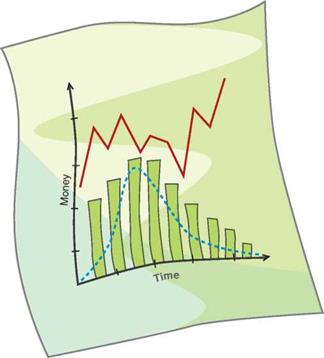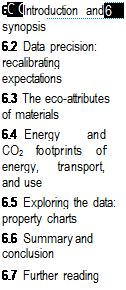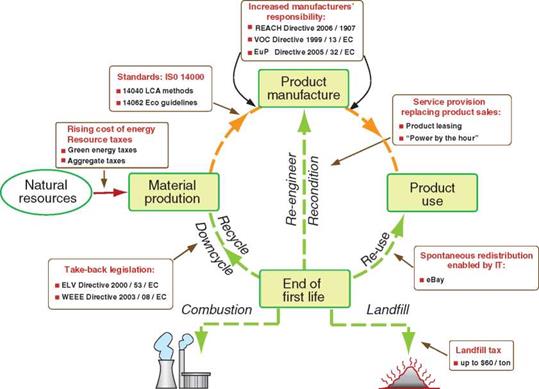The burden this legislation places on the materials and manufacturing industries is considerable. The requirements are far-reaching:
■ Documentation of the use of any one of 30,000 listed chemicals
■ Analysis of energy and material use in all energy-using products
■ Finding substitutes for VOCs and other restricted substances
■ Mandatory take-back, disassembly, and acceptable disposal of an increasingly large range of products
Figure 5.1 summarizes these interventions, suggesting where they influence the flows of the life cycle. The intention of the legislation—that of reducing resource consumption and damaging emissions and particularly of internalizing the costs these generate—makes sense. The difficulty is that implementing it generates administration, reporting, and other costs in addition to the direct costs of cleanup, thereby adding to the burden on industry.
These additional costs are minimized by the use of well-designed software and other tools. Most of the LCA packages documented in the appendix of Chapter 3 were created to help companies analyze their products, using standards that meet the requirements of the legislation. A Web search on any one of the acts and directives listed in Section 5.4 reveals
|
|
|
|
more tools designed to help implement them. The development of tools that integrate with existing product data management (PDM) systems can make compliance semiautomatic, flagging the use of any material that is, in any sense, restricted, and automatically generating the reports that the legislation requires[22].
5.2 Summary and conclusion
Governments intervene when they want to change the way people and organizations behave. Many now accept that the way they behave at present is damaging to the environment in ways that could have catastrophic consequences. Some of this damage is local and can be tackled at a national level by internalizing its cost, making the polluter pay or rewarding those that do not pollute. National and multinational regulations, controls, and directives impose reporting requirements, set tax levels, and establish trading schemes to create incentives for change, with the ultimate aim of making design for the environment a priority.
Some impacts, however, are on a global scale. The externalized costs fall on both the nations that are responsible for the impact and those that are not. Solutions, here, require international agreements. Binding, universal, and enforceable agreements here are out of reach—the diversities of GDP, national ambitions, and political systems are too great. Nonetheless, protocols and statements can be negotiated that many nations feel able to sign. If the IPCC report is to be taken seriously, it is in furthering these international agreements that we must place our hopes for the future.
But the mountain of legislation grows and grows. One only wishes that environmental agencies could aspire to be as concise as Moses.
6.1 
 |
 |
Introduction and synopsis
Decisions need data. Chapter 12 of this book provides it in the form of a compilation of data sheets for engineering materials. Each has a description and an image and lists values for engineering and ecoproperties. These provide the inputs to the audit and selection methods developed in Chapters 7, 8, and 9. The engineering properties are fully documented in standard texts listed under Further Reading. Those relating to the environment are less familiar, needing further explanation. This chapter describes them and what they mean.
The precision of a great deal of ecodata is low. The values of some are known to within 10%, others with even less certainty. So it is worth first
asking the general question: how much precision do you need to deal with a given problem? The answer: just enough to distinguish the viable alternatives. Often that does not require much. As we shall see, precise judgments can be based on imprecise data.




